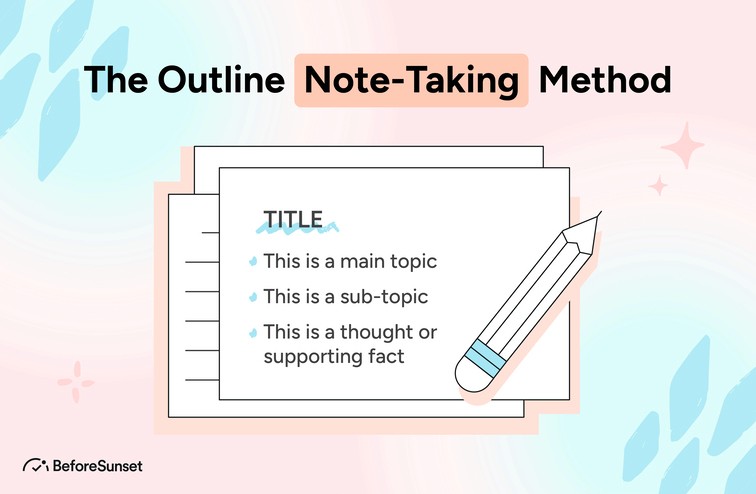The Outline Note-Taking Method is a comprehensive guide designed to equip you with the tools and techniques to take notes like a pro. Unlike traditional note-taking approaches that can lead to disorganized scribbles and disjointed thoughts, this method focuses on creating structured and coherent outlines that enable you to retain information more efficiently and access it with ease.
Within these pages, you will discover the secrets to fast note-taking without sacrificing accuracy. Whether you're a student preparing for exams, a professional attending meetings and seminars, or an individual looking to enhance your learning process, this guide will empower you to take control of your notes and harness the power of outlining to its fullest potential.
Throughout this guide, we will delve into various aspects of the Outline Note-Taking Method, including practical tips on organizing your notes, mastering the art of summarization, and integrating visual aids to reinforce your understanding. You'll learn how to capture key ideas, create hierarchies, and establish connections between concepts, ultimately leading to a comprehensive and cohesive knowledge structure.
Moreover, we understand that technology plays a significant role in modern note-taking. We'll explore various digital tools and apps that can streamline the outlining process and transform the way you approach information retention.
Whether you're a seasoned note-taker looking to refine your skills or a newcomer seeking a reliable system to improve your learning experience, "The Outline Note-Taking Method" is your roadmap to success. Embrace the power of outlining, and you'll find yourself better equipped to navigate the vast sea of information while retaining, understanding, and recalling knowledge like never before.
Get ready to take your note-taking abilities to new heights and unlock the true potential of your learning journey. Let's dive into the world of outlining and revolutionize the way you process and retain information.

Benefits of Using the Outline Note-Taking Method
The Outline Note-Taking Method offers several benefits that make it a popular choice for students, professionals, and anyone who needs to organize and retain information effectively. Some of the key advantages include:
Structure and organization: The hierarchical structure of the outline allows you to organize information in a logical and systematic way. This makes it easier to see the relationships between different ideas and concepts, leading to a better understanding of the overall topic.
Clarity and focus: Outlining helps you focus on the main ideas and key points of the lecture or presentation. By condensing information into concise phrases or bullet points, you can avoid unnecessary details and capture the essential information.
Easy review and revision: The clear and organized format of the outline makes it easy to review your notes later. You can quickly scan through the main points and sub-points, facilitating faster and more efficient revision.
Flexibility: The outline method is flexible and adaptable to various subjects and learning styles. You can use it in different settings, such as lectures, readings, or meetings, and tailor it to suit your personal preferences.
Memory retention: Structuring information through outlines aids memory retention. The act of summarizing and organizing the material in your own words reinforces learning and enhances recall during exams or when applying the knowledge in practical scenarios.
Active engagement: Outlining requires you to actively process and rephrase the information in a structured format. This active engagement with the material can enhance comprehension and critical thinking.
Time efficiency: The outline method promotes a concise and efficient way of taking notes. It helps you capture information more quickly and efficiently compared to full-sentence note-taking, enabling you to keep pace with the speaker or content.
Visual representation: Outlines often create a visual representation of information, making it easier to see the hierarchical relationships and connections between different points.
Reduces distractions: Since outlines encourage you to focus on the main ideas, they can help reduce distractions during note-taking and enhance your overall learning experience.
Personalization: Outlining allows for individual creativity and personalization. You can customize the format and style of your outlines to suit your preferences, making them more effective and enjoyable for you.
How to Use the Outline Note-Taking Method
Set up your note-taking space: Find a comfortable place to take notes, whether it's in a physical notebook or a digital note-taking app. Ensure you have all the necessary materials, such as pens, highlighters, or your preferred note-taking tools.
Title: At the top of your page or note-taking document, write down the title or topic of the lecture, presentation, or discussion. This will serve as the main heading of your outline.
Main points: Listen or read attentively and identify the main ideas or key topics being presented. Write them down as the first level of your outline, using either Roman numerals (I, II, III) or bullet points (•, ◦, -) to designate each main point.
Sub-points: Under each main point, indent or create a sub-level, and write down the supporting sub-points or details related to that main point. You can use capital letters (A, B, C) or different bullet points for the sub-points.
Supporting details: Further indent or create another sub-level to include additional supporting details, evidence, or explanations for each sub-point. Use lowercase letters (a, b, c) or sub-bullets to distinguish these supporting details.
Maintain clarity and brevity: Use concise phrases or keywords to represent each point and avoid writing full sentences unless necessary. This will help you quickly scan and review your notes later.
Leave space: Leave some space between different sections of your outline. This provides room for adding extra information during the lecture or for including additional insights while reviewing the material later.
Active listening and engagement: Engage with the material actively during the lecture or presentation. Listen carefully, ask questions, and paraphrase the information in your own words as you create the outline.
Review and revise: After the session, take some time to review your outline notes. Use this opportunity to fill in any missing information, clarify points, and ensure that your notes are accurate and complete.
Customize as needed: Feel free to personalize your outline note-taking method according to your preferences. You can experiment with different formats, colors, or highlighting techniques to make your notes more visually appealing and memorable.

Tips for Effective Outlining
Effective outlining is a powerful and versatile tool that can greatly enhance your note-taking and learning experience. Whether you're a student trying to grasp complex subjects, a professional seeking to organize meeting takeaways, or an avid learner absorbing new information, mastering the art of outlining can make a significant difference in your ability to comprehend, retain, and apply knowledge.
An outline serves as a structured framework that organizes information in a hierarchical manner, capturing the main ideas, sub-points, and supporting details of a subject. By employing this method, you can create a concise and visually appealing representation of the material, allowing you to focus on the core concepts without being overwhelmed by excessive information.
In this blog, we will provide you with valuable tips for effective outlining that will streamline your note-taking process and boost your productivity. Whether you prefer pen and paper or digital note-taking tools, these tips are applicable across various settings and subjects.
1. Make Headings Concise and Clear
Creating concise and clear headings is a fundamental aspect of effective outlining. These headings act as guideposts, offering a roadmap to navigate through the structure of the information. To achieve this, focus on using essential keywords that accurately represent the main idea of each section.
Be specific in your choice of words, ensuring that each heading reflects the content it represents without ambiguity. Consider incorporating action verbs to add clarity and engagement. Keep the headings brief while maintaining a logical order that reflects the flow of information. Avoid jargon and opt for simple language to make your outline accessible to a broader audience.
By using a consistent formatting style, such as bold or italics, and previewing the content within the headings, you create an efficient and user-friendly outline that enhances comprehension and facilitates quick review. Take the time to revise and refine your headings to ensure they effectively convey the essence of your outline, making it a valuable tool for effective learning and information retention.
2. Make Use of Subheadings to Clarify Details
Utilizing subheadings is a powerful technique to bring clarity to the details within your outline. While main headings capture the overarching themes, subheadings allow you to delve deeper and organize supporting information under specific categories.
These subheadings act as signposts, guiding you through the finer points and intricacies of the subject matter. By using descriptive subheadings, you provide context and insight into the content that follows, enhancing the overall understanding of the material.
This hierarchical approach helps you structure your notes systematically, making it easier to distinguish between different levels of information. Whether you're summarizing lecture notes, analyzing research data, or organizing meeting minutes, incorporating subheadings ensures that no crucial details are overlooked, and your outline becomes an invaluable tool for comprehensive learning and referencing.
3. Focus on Main Concepts Only
When employing the outline note-taking method, it is essential to focus solely on the main concepts. By doing so, you streamline your notes and highlight the core ideas, ensuring clarity and conciseness. Avoid the temptation to transcribe every detail verbatim, as this can lead to information overload and hinder your ability to grasp the most critical points. Instead, actively listen, read, or participate in discussions to identify the key takeaways.
Capture these main concepts in your outline, using clear and succinct language. This selective approach allows you to absorb information more effectively, maintain engagement during lectures or meetings, and facilitate effortless review and revision. By honing in on the main concepts, your outline becomes a potent tool for organized and efficient learning, enabling you to retain essential knowledge and apply it effectively in various contexts.
4. Use Useful Visual Aids if Necessary
Including helpful visuals in your notes will help you better comprehend the topic and make your outline much more successful. Complex topics may be represented visually with the use of visual aids like diagrams, charts, graphs, and pictures, which makes them simpler to understand and recall.
When appropriate, think about adding these illustrations to your outline to help highlight the key themes and connections between various ideas. Additionally, using visual aids makes learning more dynamic and engaging, grabbing your interest and promoting involvement.
Using pertinent visual aids may assist clarify abstract material and foster a more comprehensive grasp of the subject matter, whether you're learning from textbooks, attending data-driven presentations, or researching complicated subjects. Use visual aids sparingly, ensuring that they support your outline and benefit your note-taking strategy as a whole.
5. Use a System That Works for You
Use a strategy that is most beneficial for you when it comes to effective outlining and note-taking. There is no one-size-fits-all strategy since everyone has different learning preferences, organizational styles, and organizing approaches.
Try out various note-taking formats, outlining methods, and digital or analog instruments to see what works best for you. Find a method that meets your needs and increases your productivity, whether you like classic pen and paper, digital note-taking tools, or a combination of the two.
You may tailor your learning experience and increase the effectiveness of your note-taking by adapting your outlining technique. Your ability to absorb, remember, and apply knowledge will improve as you customize your system to fit your learning style and strengths. This will speed up your learning process and help you succeed in both your academic and professional endeavors.

Common Mistakes to Avoid in Outline Note-Taking
Outline note-taking is a valuable skill, but like any technique, it can be prone to certain mistakes that may hinder its effectiveness. Here are some common mistakes to avoid when using the outline note-taking method:
Overloading with details: One of the primary benefits of outlining is to focus on main ideas. Avoid the mistake of including too many supporting details or writing in full sentences. Stick to concise phrases that capture the essence of the content.
Lack of organization: Without a clear hierarchical structure, your outline may become chaotic and challenging to follow. Always ensure a logical flow from main points to sub-points, maintaining a consistent structure.
Ignoring signal words: Signal words like "first," "next," "finally," "in contrast," etc., help in understanding relationships between different points. Neglecting these words can make it difficult to see connections in the material.
Not reviewing and revising: Failing to review and revise your outline after the note-taking session can lead to incomplete or unclear notes. Take the time to fill in any missing information and ensure accuracy.
Not differentiating between main and sub-points: Make sure to clearly distinguish between main points and sub-points. Use appropriate numbering or bulleting to maintain clarity.
Copy-pasting information: Avoid the temptation to copy-paste large chunks of text
Outline Note-Taking Method Vs. Other Note-Taking Methods
The outline note-taking method is just one of several note-taking techniques available. Each method has its strengths and weaknesses, and the best approach often depends on the individual's learning style, the type of content being recorded, and personal preferences. Let's compare the outline note-taking method with some other common note-taking methods:
Outline Note-Taking Method:
Strengths: Provides a clear and organized hierarchical structure, making it easy to identify main ideas and supporting details. Promotes efficient review and retention of information. Ideal for structured lectures, presentations, and academic subjects.
Weaknesses: May not be suitable for capturing a lot of detail or in-depth explanations. Can be less effective for note-taking in fast-paced, unstructured discussions.
Cornell Note-Taking Method:
Strengths: Divides the page into distinct sections for main points, cues, and summaries, facilitating easy review and organization. Encourages active engagement and reflective thinking during the note-taking process.
Weaknesses: Requires more time and effort during note-taking compared to other methods. May not be as flexible for various types of content.
Mind Mapping:
Strengths: Stimulates creative thinking and associations between concepts. Visually appealing and great for brainstorming, planning, and organizing interconnected ideas.
Weaknesses: Can be less structured, making it challenging for some to grasp the overall flow of information. Not ideal for capturing linear information or detailed explanations.
Charting Method:
Strengths: Effective for organizing information into tables or charts, making comparisons, and highlighting key points. Useful for data-driven subjects and scientific information.
Weaknesses: Less suitable for capturing lengthy explanations or narrative content. May not be as effective for subjects with more qualitative information.
Sentence Method:
Strengths: Involves writing notes in complete sentences, providing detailed information and context. Ideal for capturing complex ideas and comprehensive explanations.
Weaknesses: Can be time-consuming and may hinder active listening and engagement. Can lead to excessive note-taking and information overload.

Is Outline Note-Taking Method Right for You?
The outline note-taking approach may or may not be appropriate for you, depending on a number of variables. The outline method might be ideal if you want to take notes in a systematic and organized way. It is excellent at concisely and logically expressing key ideas, connections between concepts, and supporting information, which makes it perfect for academic subjects and organized lectures.
The outline technique may be quite helpful if you value your capacity to evaluate and remember knowledge well. However, you can look at different note-taking techniques if you want to write down every little detail or find the hierarchical structure to be too strict for some sorts of discussions.
The goal is to figure out whether the outline note-taking approach fits your needs and improves your entire learning experience by taking into account your learning preferences, the sorts of information you frequently encounter, and your learning style. If the outline approach appeals to you, adopting it and personalizing it might greatly improve your note-taking skills.
Use BeforeSunset
BeforeSunset is a productivity solution designed to help busy professionals and teams stay organized and efficient. Using the Outline Note-Taking Method, BeforeSunset can help busy professionals quickly and accurately capture the main points of a lecture or meeting. With BeforeSunset's AI-powered scheduling feature, you can easily create a schedule with just a click, saving you time and energy so you can focus on more important tasks. Try BeforeSunset and see for yourself how quickly and easily you can create an outline and capture the main points of a lecture or meeting.


